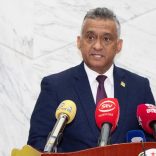Mozambique approves waiver of social security fines regime
Mozambique: Mandatory bank reserves shrink by 22% in January from record highs

File photo: Lusa
The mandatory reserves that banks operating in Mozambique are obliged to hold at the central bank shrank by 22% in January, to 227.127 billion meticais (€3.268 billion), from the previous record highs resulting from stricter requirements, official data consulted by Lusa show.
According to data from statistical reports by the Bank of Mozambique – which in the meantime has eased the restrictive measures surrounding these reserves in January – the volume of these mandatory deposits had previously reached historic highs.
In December, these reserves totalled 291.457 billion meticais (€4.194 billion), according to the central bank’s update.
The mandatory reserves of commercial banks at the central bank were set by the Bank of Mozambique at 10.5 per cent in national currency and 11 per cent in foreign currency at the beginning of January 2023. However, in the first six months of 2023, the central bank increased the coefficient twice in order to ‘absorb excessive liquidity in the banking system, with the potential to generate inflationary pressure’.
The last of these increases took place in June 2023, reaching 39 per cent of deposits in national currency and 39.5 per cent in the case of foreign currency to be held in bank reserves.
Since the end of December 2022, when they totalled 62,144 million meticais (894 million euros), the volume of bank reserves held by the central bank has increased by almost 400%.
Faced with a lack of foreign currency on the domestic market, Mozambican businesses have in recent months emphasised the need for the central bank to ease the mandatory reserve coefficients in foreign currency.
That decision only came on 27 January this year, when the Monetary Policy Committee (CPMO) of the Bank of Mozambique decided to cut the mandatory reserve coefficients in national currency to 29% and in foreign currency to 29.5%.
The move’s aim, according to the statement from the CPMO meeting, was “to provide more liquidity to support the economy in restoring productive capacity and the supply of goods and services.”
Meanwhile, the governor of the Bank of Mozambique, Rogério Zandamela, said on 26 March that liquidity in the financial system was is sufficient, particularly in foreign currency, following the reduction in the coefficients decided in January, which he does not plan to repeat for the time being.
“At the moment we are calm about the level of liquidity that exists in the system, there is no need to touch on structural liquidity, messing with mandatory reserves,” said the governor, questioned by journalists at the end of the last CPMO meeting. “We’re going to maintain it. It’s not something you play around with, with the coefficients.”
At this March’s meeting, the CPMO once again cut the interest rate, now to 11.75%, but kept the mandatory coefficients unchanged, with Zandamela justifying that the measure adopted at the previous meeting had “freed up a lot of liquidity” in the meantime.
“Just to give you an idea of the order, all this together, in meticais alone, we’re talking about at least fifty-five billion meticais [€798.2 million], and almost two hundred and fifty million [dollars, €231.8 million] in terms of foreign currency, which has been freed up for the normal functioning of the economy,” he stressed.












Leave a Reply
Be the First to Comment!
You must be logged in to post a comment.
You must be logged in to post a comment.